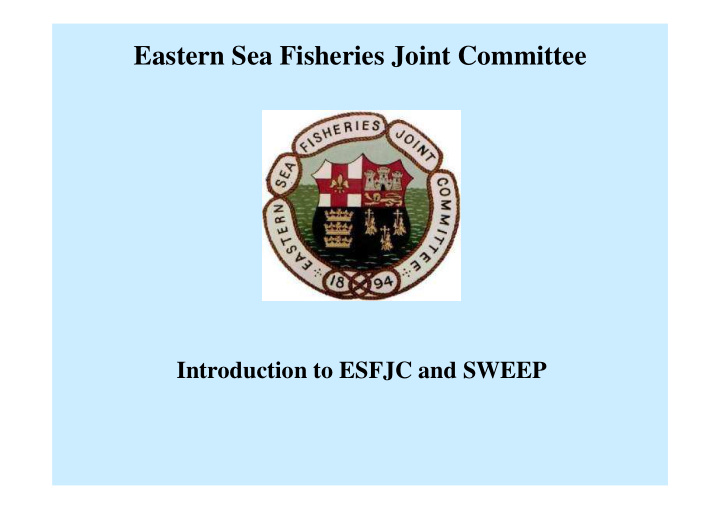



Eastern Sea Fisheries Joint Committee Introduction to ESFJC and SWEEP
Eastern Sea Fisheries Joint Committee “to regulate, protect and develop the fisheries within the Joint Committee’s District in a manner that ensures sustainable viability for the foreseeable future and compliance with the Joint Committee’s environmental responsibilities”
ESFJC District ESFJC District Lincolnshire Norfolk 6nms Suffolk
The Wash Most important area in ESFJC District, for commercial fisheries and for nature conservation • Key fisheries: cockle, mussel, shrimp, lobster • Annual first sale value £4-6M • European and national conservation importance: SAC, SPA, Ramsar site, SSSI, NNR • Wash cockle and mussel fisheries managed through the Wash Fishery Order 1992 and ESFJC Byelaws
Joint Committee composition Elected Members (10) Defra Appointees (10) Lincolnshire County Councillors (3) Commercial fishing representatives (6) Norfolk County Councillors (4) Recreational sea angling representatives (2) Suffolk County Councillors (3) Environment Agency representative (1) 2009/2010 levy £1,248,450 Environmental specialist (1)
Post Number Clerk & Chief Fishery Officer 1 Deputy Clerk & Fishery Officer 1 Skipper/Fishery Officer 2 Mate/Fishery Officer 2 Engineer/Fishery Officer 2 Senior Research Officer/Fishery Officer 1 Research Officer/Fishery Officer 2 Area Fishery Officer 4 Crewman/Fishery Officer 1 Finance Officer 1 Administrative Officer 1 Clerical Officer 1 Marine Environment Officer * 1 European Marine Site Manager * 1 Total personnel 21*
Enforcement Enforcement of EU, UK & local (byelaws) legislation Fisheries Protection Vessels = 3* • ESF Protector III • Sea Spray • Pisces III
Research & Environment Research Vessels: Three Counties, Runner Dedicated research & environment personnel Increase in environmental legislation Requirement for detailed baseline information
ESFJC Survey Programme - Cockles Spring and Autumn surveys 21 beds surveyed 1,314 sample stations in regular grid pattern
Cockle Data
Additional data – 2007 onwards Map the distribution of sediment types over the survey areas Map the distribution of: Macoma Arenicola Lanice
ESFJC Survey Programme – Intertidal Mussels Autumn surveys 20 beds surveyed at low water Measure area, coverage, density and size frequency
Discard Mortality Research
Acoustic Ground Discrimination Surveys Been using Roxann AGDS for approximately 15 years to locate sublittoral mussel beds and Sabellaria spinulosa reefs
Study of the Wash Embayment Environment and Productivity • Prompted by unexplained high cockle mortalities in 2008
Changes to Cockle Stock Biomass 2008-09 Boston Main – 9,000 tonnes Gat Sand – 2,180 tonnes Roger/Toft – 760 tonnes Holbeach – 1,180 tonnes IWMK – 990 tonnes
Possible Cause of Mortality • Exceptional 2004 and 2006 settlements covering same distribution • Competition between two cohorts results in the loss of the 2004 cohort in 2007 and stress in the 2006 cohort • Combined stocks of cockles, mussels and Ensis directus reach historic peak in 2008 • Poor growth rates seen in mussel stocks from several fishery • Has carrying capacity been exceeded?
Combined areas of cockle and mussel
Wash Productivity Study 1. Ascertain whether food limitations may have been responsible for cockle mortality event? 2. Investigate primary productivity and shellfish carrying capacity in the Wash
ESFJC Water Quality Sampling
Recommend
More recommend